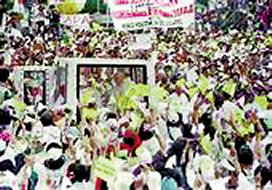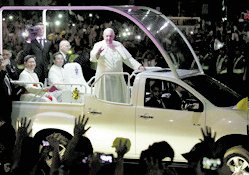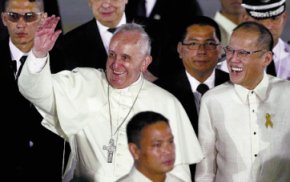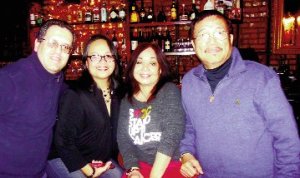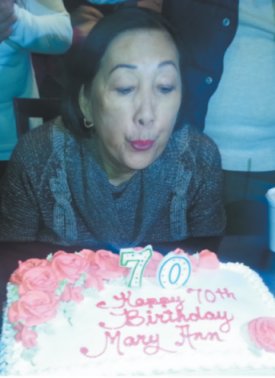Pope Francis arrived in the Philippines, Asia’s most Catholic nation and one hungry for his arrival, last January 15, 2015, for a five-day stay the highlight of which is the visit to Tacloban, Leyte, the island that was hardest hit by typhoon Haiyan last year..
Everything from the country’s supreme court to backstreet businesses have closed down, but the streets have come alive.
People have been pouring into the capital from all over the country to greet the head of the Catholic Church as he starts his five-day visit.
On street corners, in malls, on public transport, it’s impossible not to feel the presence of the Pope.
Giant billboards with an official red and blue “Pope logo” adorn many of Manila’s buildings, while curbside vendors sell images of his smiling face on everything from stamps and towels to fans and key chains.
Filipinos have been granted a national holiday for the visit, the coast guard has declared a no-sail zone within a mile of Manila Bay, many of the capital’s main roads are closed, and Manila’s airport has limited its operations.
An estimated 40,000 security personnel were deployed to keep the Pope safe during his time in Manila and Leyte, where he will celebrate Mass in Tacloban, a city still coming to terms with the devastation caused by Typhoon Haiyan a year ago.
Pope Francis’ visit is being billed as one of “mercy and compassion.” But in a country where a conservative church has fought strongly against legislation allowing government distribution of birth control, as well as the legalization of divorce, some Filipinos hope this pontiff’s more open-minded approach might lead to change.
Young people, such as John Laureta, a 24-yearold student who is traveling six hours to see the Pope in the capital, says he’s the kind of leader in the church that the young need. “He’s approachable, listens and answers questions, explains and does not ignore questions that are controversial,” he said.
One shopper in Manila decides to remember the Pope’s historic visit with a coffee mug.
Ginelle Peterson, also 24, agreed. “Since he is not so black-and-white, it makes us think, ‘I want to hear more of what he has to say about this,'” she said.
Indeed, for many people in the Philippines, having a head of church with these qualities is welcome.
Anthony J. Vizmanos, 25, was asked to leave his home when he came out as gay to his “deeply religious” parents. He said he still prays, goes to church and receives sacraments but has been driven away by what he calls irony in the church’s teachings.
“The church says it’s OK to be gay as long as you don’t engage in homosexual acts. But if you say you accept us for being gay, then why are you stopping us from acting gay? We are not plants that photosynthesize. We need love and affection, too.”
Vizmanos, who went to Catholic schools for most of his life, told CNN, “I no longer join Catholic community groups. I practice what I know and believe instead of what they are telling me to believe.” (CNN)
Pope Francis’s advisers fear for his security in Philippines
Authorities in the Philippines have appealed to the huge crowds who turn out to see Pope Francis not to turn “a moving target into a stationary one” by blocking his Popemobile, as the South American pontiff arrived in Manila for a five-day visit.
There is acute concern for Pope Francis’s safety during his first visit to the South-east Asian country, where he is expected to be mobbed by millions of devout Catholics.
President Benigno Aquino pleaded with Filipinos not to block the papal convoy by attempting to reach out to the Argentinian pontiff or try to take “selfie” pictures, saying that to do so would turn a moving target into a much more vulnerable stationary one.
“If someone blocks the convoy by trying to get near the Holy Father and the convoy stops, what was a moving target becomes a stationary target,” he said earlier this week, before the Pope’s arrival.
Up to six million Catholics attended a Mass given by Pope Francis in a park in Manila. “There is no doubt that in a large gathering like this, there is a possibility of chaos even without the threat of terrorism, and an even greater possibility if someone plans to cause chaos,” Mr Aquino said in a televised address to the nation.
“I ask you, do you want history to record that a tragedy involving the Pope happened in the Philippines?” The president warned that even one person trying to break through the security cordon could trigger a stampede, adding: “There might be some people who may want to get a ‘selfie’.”
The history of past papal visits to the Philippines is not encouraging – during the first-ever pontifical visit in 1970, a Bolivian painter, Benjamin Mendoza, donned a fake cassock and swung a knife at Pope Paul VI as he arrived at Manila airport. The Pope was wounded but continued his trip without disclosing the injury.
In 1995, a week before John Paul II’s visit, police uncovered a plot by foreign Islamist extremists to kill him by bombing his motorcade route in Manila.
The plot was led by Ramzi Yousef, the mastermind of the 1993 World Trade Center bombing.Pope Francis’s refusal to travel in a bullet-proof vehicle makes security even more of a headache.
He has repeatedly rejected bullet-proof Popemobiles, both in Rome and on foreign trips to potentially risky places such as Rio de Janeiro, Istanbul, Albania and the Holy Land. He says open-topped vehicles enable him to interact more freely with the crowds.
“I cannot greet the people and tell them I love them from inside a sardine can, even if it is made of glass. For me it is a wall,” he said last summer.
There are fears that an attempt on the Pope’s life could be made by the Islamic militant group Abu Sayyaf, although it operates mostly in the south of the country.
An assessment of potential threats, compiled by the Philippines government, identified home-grown Islamist groups as well as al-Qaeda and Isil, which has repeatedly threatened to “conquer Rome” and plant its black flag on St Peter’s Basilica.
Nearly 50,000 soldiers and police are being deployed to protect the pontiff during his trip to the Philippines, where around 80 per cent of the population is Catholic.
Gridlock is expected to be so bad in Manila that 2,000 traffic police have been ordered to wear adult nappies, so that they can answer the call of nature on the spot and not have to abandon their posts.
“For this year, this will be the greatest security nightmare that we can have,” said General Gregorio Catapang, of the Philippine military.The authorities have insisted that they have received no specific intelligence about a plot to harm the Pope.
But he would be a tempting target for the country’s Islamic militants. “For violent groups opposed to the rule of the Catholic Church, attacking the Pope is like a trophy, a major accomplishment,” Rommel Banlaoi, director of the Philippine Institute for Peace, Violence and Terrorism Research, told AFP.
“The most challenging threat would come from a lone-wolf attack. It is easier to monitor bad elements coming from identified violent groups.”
Asked if he was nervous ahead of the Pope’s arrival, Wilben Mayor, a spokesman for the Philippine National Police, said: “For a long time now, yes. This is very challenging for the PNP.”
The Pope brings a message of solidarity for the millions of Filipinos who live in poverty, and to visit the central province of Leyte, which is still struggling to recover from Typhoon Haiyan, which killed 6,300 people in 2013.(Telegraph)
(1) Huge crowd that awaits Pope Francis’ arrival last Jan.15th; (2) Pope riding the PopeMobile and refusing the bullet-proof vehicle; (3) President Ninoy Aquino with Pope Francis during the red-carpeted walk-thru in Malacanang.
 VIA Times – January 2015 Issue Vital News, Vibrant VIews for Asian Americans in Chicago & Midwest
VIA Times – January 2015 Issue Vital News, Vibrant VIews for Asian Americans in Chicago & Midwest


